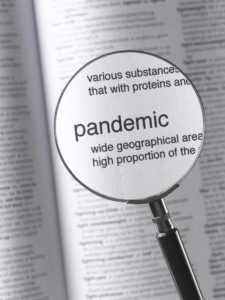April 1, 2020
By Dwight Akerman, OD, MBA, FAAO
Chief Medical Editor, Review of Myopia Management
 Many experts have written that the global myopia crisis is an epidemic, while others have called it a pandemic. According to the U.S. Centers for Disease Control and Prevention, “epidemic refers to an increase, often sudden, in the number of cases of a disease above what is normally expected in that population in that area.” Pandemic “refers to an epidemic that has spread over several countries or continents, usually affecting a large number of people.”1 The textbook example of a pandemic is COVID-19, currently sweeping throughout the world.
Many experts have written that the global myopia crisis is an epidemic, while others have called it a pandemic. According to the U.S. Centers for Disease Control and Prevention, “epidemic refers to an increase, often sudden, in the number of cases of a disease above what is normally expected in that population in that area.” Pandemic “refers to an epidemic that has spread over several countries or continents, usually affecting a large number of people.”1 The textbook example of a pandemic is COVID-19, currently sweeping throughout the world.
Every region of the world is showing alarming increases in myopia prevalence. These growths are associated with significantly increased risks for vision impairment from pathologic conditions related to myopia, including retinal detachment, myopic macular degeneration, cataract, and glaucoma.2 In 2020, it is estimated that 34 percent (2.620 billion) of the global population is myopic. By 2030, it is predicted that 40 percent (3.361 billion) of the worldwide population will be myopic.3
Based on these data and the CDC definition, myopia should be considered a pandemic. Moving forward, let’s use this terminology when describing myopia trends.
With so many treatment alternatives available that have demonstrated efficacy, eye care professionals have a professional responsibility to discuss myopia management options with all parents of children at risk for progressive myopia. Working together, we can reverse the myopia pandemic.
Best professional regards,

Dwight H. Akerman, OD, MBA, FAAO, FBCLA
Chief Medical Editor
dwight.akerman@gmail.com
1 Dicker, R. C., Coronado, F., Koo, D., & Parrish, R. G. (2006). Principles of epidemiology in public health practice; an introduction to applied epidemiology and biostatistics.
2 WHO. (2017). The Impact of Myopia and High Myopia: Report of the Joint World Health Organization-Brien Holden Vision Institute Global Scientific Meeting on Myopia.
3 Holden, B. A., Fric ke, T. R., Wilson, D. A., Jong, M., Naidoo, K. S., Sankaridurg, P., … & Resnikoff, S. (2016). Global prevalence of myopia and high myopia and temporal trends from 2000 through 2050. Ophthalmology, 123(5), 1036-1042.













